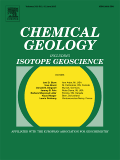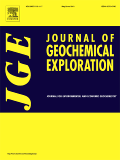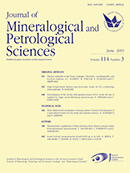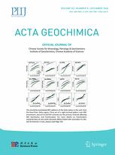
MINERALOGICAL MAGAZINE
Scope & Guideline
Unveiling the Secrets of Minerals and Their Impact
Introduction
Aims and Scopes
- Mineral Discovery and Description:
The journal regularly publishes detailed studies on newly discovered minerals, including their crystal structures, chemical compositions, and classification within existing mineralogical frameworks. - Experimental and Theoretical Mineralogy:
Research that employs experimental techniques, such as high-temperature and high-pressure studies, as well as theoretical modeling, contributes significantly to understanding mineral behavior under various conditions. - Mineral Classification and Nomenclature:
The journal actively engages with the International Mineralogical Association's Commission on New Minerals, Nomenclature and Classification, facilitating discussions and updates on the classification and nomenclature of minerals. - Geochemistry and Mineral Formation Processes:
Studies exploring the geochemical processes involved in mineral formation, alteration, and the mobility of elements during geological processes are a core focus area, providing insights into mineral genesis. - Environmental and Economic Geology:
The journal includes research on the economic significance of minerals, including their extraction and environmental impacts, highlighting the importance of sustainable practices in mineral resource management. - Interdisciplinary Approaches:
The integration of mineralogy with other scientific disciplines, such as petrology, geochemistry, and environmental science, is encouraged to foster a holistic understanding of mineral systems.
Trending and Emerging
- Mineral Synthesis and Experimental Techniques:
There is a notable increase in papers focusing on the synthesis of new minerals in laboratory settings, utilizing advanced experimental techniques to explore their properties and potential applications. - High-Pressure and High-Temperature Studies:
Research investigating mineral behavior under extreme conditions is gaining traction, providing insights into the stability and transformations of minerals in the Earth's interior. - Environmental Mineralogy:
An emerging focus on the environmental implications of minerals, including studies on mineral weathering, biogeochemical cycles, and the role of minerals in pollution mitigation, reflects growing ecological awareness. - Digital Mineralogy and Data Analysis:
The adoption of digital tools and data analysis techniques, such as machine learning for mineral classification and characterization, is becoming increasingly prominent, showcasing the integration of technology in mineralogy. - Mineral Resources and Sustainability:
Research addressing the sustainable extraction and management of mineral resources is on the rise, emphasizing the need for environmentally responsible practices in mining and mineral processing.
Declining or Waning
- Traditional Mineralogy:
Research focused solely on traditional descriptive mineralogy, without integrating modern analytical techniques or interdisciplinary approaches, appears to be declining as the field evolves. - Minerals in Historical Context:
Papers exploring the historical aspects of mineralogy, such as mineral collections or historical mining practices, have become less frequent, possibly due to a shift towards more applied and contemporary studies. - Mineralogical Surveys of Well-Studied Regions:
Surveys and studies of mineral occurrences in regions that have already been extensively documented are decreasing, as researchers focus on more novel locations or unexplored mineral assemblages. - Static Mineral Properties:
Research concentrating on static properties of minerals, such as basic crystallography without context of environmental conditions or applications, is waning in favor of dynamic studies that consider mineral behavior under variable conditions.
Similar Journals

GEOLOGY OF ORE DEPOSITS
Pioneering Research in Geological SciencesGEOLOGY OF ORE DEPOSITS, published by PLEIADES PUBLISHING INC, stands as a pivotal resource in the fields of Economic Geology, Geochemistry, and Petrology. With an ISSN of 1075-7015 and an E-ISSN of 1555-6476, this esteemed journal caters to researchers and professionals by publishing rigorous studies on the formation, distribution, and exploration of mineral deposits. Although it operates under a subscription model, the journal offers insights that are vital for advancing knowledge in geological sciences. As represented in the Scopus rankings, it holds respectable positions within its categories—ranked Q3 in Economic Geology, Geochemistry and Petrology, and Geology for 2023, reflecting its significant contribution to the academic discourse. Covering a comprehensive timeframe from 1996 to 2024, it appeals not only to seasoned scholars but also to students seeking to deepen their understanding of ore deposit geology, thus fostering a rich learning environment and enhancing the field's scientific foundation.

CHEMICAL GEOLOGY
Illuminating Earth’s Mysteries with Cutting-Edge ResearchChemical Geology is an esteemed international journal published by Elsevier, dedicated to the rigorous exploration of geochemistry and petrology, with its foundational roots tracing back to 1966. As evidenced by its impressive Q1 ranking in both Geochemistry and Petrology as well as Geology in the 2023 category quartiles, this journal stands as a premier outlet for cutting-edge research and innovative methodologies within these vital fields. With a Scopus rank placing it in the top 10% of Earth and Planetary Sciences, Chemical Geology offers a platform for researchers, professionals, and students alike to disseminate findings that advance our understanding of geological processes and materials. Although it does not currently offer open-access options, the journal remains committed to high-quality publications that contribute significantly to the scholarly community. Located in the vibrant academic milieu of Amsterdam, Netherlands, Chemical Geology is an essential resource for those engaged in the earth sciences, aiming to bridge theoretical insights with practical applications.

Periodico di Mineralogia
Connecting Scholars in the World of MineralogyPeriodico di Mineralogia, published by SAPIENZA UNIV EDITRICE, is a distinguished academic journal based in Italy that has been pivotal in advancing the fields of Geochemistry, Geology, and Geophysics since its inception in 1979. With an ISSN of 0369-8963 and an E-ISSN of 2239-1002, the journal boasts a solid reputation reflected in its Q3 category rankings across these disciplines as per 2023 metrics. The journal’s scope encompasses a broad range of topics related to mineralogy and earth sciences, providing a vital platform for researchers, professionals, and students to disseminate their findings. Despite the absence of an Open Access option, Periodico di Mineralogia remains an essential resource for the dissemination of high-quality research that contributes to our understanding of earth processes and materials. Situated in the heart of Rome at PIAZZALE ALDO MORO 5, it serves as a crucial bridge between academic research and practical applications in geology and planetary sciences.

JOURNAL OF GEOCHEMICAL EXPLORATION
Advancing Insights in Geochemistry and Economic GeologyJOURNAL OF GEOCHEMICAL EXPLORATION, published by Elsevier, is a leading journal in the fields of Geochemistry and Economic Geology, with a notable Impact Factor and a commendable performance demonstrated by its Scopus ranking, where it holds the 22nd position out of 154 in Geochemistry and Petrology and 11th out of 43 in Economic Geology. Founded in 1972 and set to converged through 2024, the journal serves as a vital platform for disseminating high-quality research, providing insights into the complex relationships between geological processes and geochemical phenomena. Its articles contribute significantly to the understanding of natural resource exploration and environmental geochemistry, making it an essential resource for researchers, industry professionals, and students alike. Although not an open-access journal, it offers a wealth of knowledge aimed at advancing the field's boundaries and fostering innovative research initiatives. As an established outlet for the latest findings and methodologies, the journal's contributions ensure it remains at the forefront of geochemical exploration.

Mining of Mineral Deposits
Advancing the Future of Mining ResearchMining of Mineral Deposits, published by the NATIONAL MINING UNIVERSITY in Ukraine, stands as a pivotal journal in the fields of engineering and earth sciences, evidenced by its commendable rankings across various categories, including a Q1 classification in Engineering (miscellaneous) and notable placements in Geochemistry and Geotechnical Engineering (Q2) for 2023. With an ISSN of 2415-3435 and E-ISSN 2415-3443, this journal provides a dedicated platform for researchers, professionals, and students alike to disseminate significant findings pertaining to mineral deposits and mining technologies. The journal has evolved over the years, bridging vital research gaps since its inception in 2016, and aims to enhance knowledge and collaboration within the mining community. Although it operates under limited access options, its rigorous peer-review process ensures that only high-quality research is published, all contributing to its respectable impact factor and visibility in the academic landscape. Located in Dnipropetrovsk, this journal not only serves as a repository of knowledge but also promotes advancements in sustainable mining practices and resource management, making it an essential resource for those engaged in mineral exploration and extraction.

CONTRIBUTIONS TO MINERALOGY AND PETROLOGY
Advancing the Frontiers of Mineralogy and PetrologyCONTRIBUTIONS TO MINERALOGY AND PETROLOGY, published by SPRINGER, is a premier journal in the fields of geochemistry, petrology, and geophysics, boasting an impressive impact factor that reflects its status as a leader in the discipline. With a history spanning from 1966 to 2024, this journal has consistently provided a platform for high-quality research that influences our understanding of earth materials and processes. Ranked in the top quartile (Q1) in both geochemistry and petrology, as well as geophysics, it stands out with Scopus rankings of #24 out of 165 in Geophysics and #37 out of 154 in Geochemistry and Petrology, indicating its critical role in advancing scientific knowledge. As a vital resource for researchers, professionals, and students alike, the journal invites contributions that foster collaboration and innovation in the study of minerals and rocks. Although it does not currently offer open access, its scholarly rigor and relevance to contemporary issues ensure it remains an indispensable part of the academic discourse within this field.

PETROLOGY
Fostering Innovation in Geochemical ResearchPETROLOGY is a significant journal in the field of Geochemistry and Petrology, published by PLEIADES PUBLISHING INC in the United States. With an ISSN of 0869-5911 and an E-ISSN of 1556-2085, this journal has established itself as a valuable resource since its inception in 1996, continuing to provide insights into various aspects of petrology and geochemical processes through to 2024. It holds a Q3 ranking in the 2023 category quartiles for Geochemistry and Petrology, placing it within the academically relevant tier of journals as recognized by Scopus. Although it does not currently offer open access, the journal remains accessible to researchers, professionals, and students eager to explore the intricate relationships between mineral compositions and geological phenomena. By publishing high-quality research and reviews, PETROLOGY plays a crucial role in advancing knowledge, contesting existing paradigms, and fostering discussions on both fundamental and applied topics within the petrology domain.

Journal of Mineralogical and Petrological Sciences
Decoding the Earth's Mysteries, One Article at a TimeThe Journal of Mineralogical and Petrological Sciences, published by the Japan Association of Mineralogical Sciences, serves as a vital platform for disseminating high-quality research in the fields of mineralogy and petrology. With a presence in both traditional and digital formats (ISSN: 1345-6296; E-ISSN: 1349-3825), this journal fosters scholarly engagement and innovation within these crucial branches of Earth Sciences. As evidenced by its Q3 ranking in both Geology and Geophysics categories for 2023, Journal of Mineralogical and Petrological Sciences maintains a significant standing within the academic community, contributing to the ongoing discourse and exploration of mineralogical phenomena and processes. Researchers, professionals, and students alike will find valuable insights and advancements represented within its pages, with a commitment to inclusivity in research output spanning two decades (2000-2024). Although not currently open access, the journal remains a key resource for understanding the complexities of our geological world.

LITHOLOGY AND MINERAL RESOURCES
Uncovering Insights in Geochemistry and PetrologyLITHOLOGY AND MINERAL RESOURCES, published by PLEIADES PUBLISHING INC, is a specialized journal dedicated to advancing knowledge in the fields of economic geology, geochemistry, and petrology. With its ISSN 0024-4902 and E-ISSN 1608-3229, this journal has established itself as a critical resource for scholars and practitioners alike, examining the intricate relationships between lithology and mineral deposits, and their implications for resource management. As indicated by its positioning in the Q3 quartile for both economic geology and geochemistry and petrology in 2023, the journal is recognized for its valuable contributions to the scientific community, ranking #28 out of 43 in Economic Geology and #112 out of 154 in Geochemistry and Petrology according to Scopus. The journal's publication history reveals a rich tradition of excellence, as it has been continuously contributing to the field from 1984 to 2024. While it does not offer open access options, researchers and practitioners can easily engage with its robust body of work in effective ways to support their own studies and applications. The importance of LITHOLOGY AND MINERAL RESOURCES lies in its commitment to publishing high-quality research that informs practices in mineral exploration and environmental stewardship, making it an essential resource for anyone invested in the future of earth sciences.

Acta Geochimica
Advancing Geochemical Knowledge for a Deeper Understanding.Acta Geochimica is a prominent academic journal published by SPRINGER INT PUBL AG, focusing on the dynamic fields of Geochemistry and Petrology. Established in 2016, this peer-reviewed publication has quickly gained recognition within the scientific community, currently holding a category quartile ranking of Q3 in Geochemistry and Petrology as of 2023. With its ISSN 2096-0956 and E-ISSN 2365-7499, the journal offers a platform for researchers and professionals to disseminate and discuss significant advancements in the study of the chemical composition of the Earth and other celestial bodies. While it is not an open-access journal, Acta Geochimica plays a vital role in fostering collaboration and innovation among scientists, contributing to a deeper understanding of geochemical processes. Located in Switzerland at Gewerbestrasse 11, Cham CH-6330, Switzerland, this journal is a critical resource for students, researchers, and professionals seeking to push the boundaries of knowledge in Earth sciences.